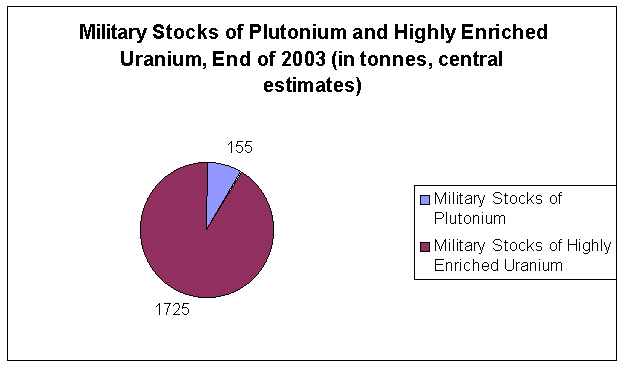Reports
Global Stocks of Nuclear Explosive Material – End 2003 (Updated 2004)
June 30, 2004
Global Plutonium and Highly Enriched Uranium (HEU) Stocks:
Summary Tables and Charts
June 30, 2004
Table 1: Global Plutonium and Highly Enriched Uranium (HEU) Stocks, by Origin, end 2003
Table 2: Global Plutonium and Highly Enriched Uranium (HEU), Assigned to Civil or Military Stocks, end 2003, in tonnes
Chart 1: Global Inventory of Plutonium (in tonnes, central estimates)
Chart 2: Global Stocks of Plutonium and Highly Enriched Uranium, End of 2003 (in tonnes, central estimates)
Chart 3: Civil and Military Stocks of Fissile Material (Plutonium and HEU), End of 2003 (in tonnes, central estimates)
Chart 4: Civil Stocks of Plutonium and Highly Enriched Uranium, End of 2003 (in tonnes, central estimates)
Chart 5: Military Stocks of Plutonium and Highly Enriched Uranium, End of 2003 (in tonnes, central estimates)
Table 1:Global Plutonium and Highly Enriched Uranium (HEU) Stocks, by Origin, end 2003, in tonnesa
| Category | Plutonium | HEU | Total | ||||||||||||
| Civil Origin | 1,595 | 50?b | 1645 | ||||||||||||
| Irradiated | 1365 | ? | |||||||||||||
| Unirradiated | 230c | ? | |||||||||||||
| Military Origin | 260 | 1850 | 2110 | ||||||||||||
| Primary | 153 | 1250 | |||||||||||||
| Naval and Other | – | 175 | |||||||||||||
| Excess | 107 | 425 | |||||||||||||
| Total | 1855 | 1900 | 3755 |
(a) These stocks of HEU and plutonium are organized by origin, which is defined here as which entity, military or civilian, had custody of the material as of January 1, 1994. This date was selected, because in 1994 the United States declared excess plutonium and HEU. Some of this excess material was then assigned to civil inventories. In this table, those quantities are listed as the excess stock in the military origin category.
[back to the table]
(b) The civil HEU stock does not include roughly 10 tonnes of US and foreign civil HEU that is owned by the Department of Energy. This amount is included in the excess HEU amount.
[back to the table]
(c) This value does not include about 4-5 tonnes of US unirradiated plutonium that was originally produced in civil power reactors. As of January 1, 1994 this plutonium was part of the US military program and later part of the 52.5 tonnes the United States declared excess. For more information about unirradiated plutonium produced in civil power reactor programs, see ‘Separated Civil Plutonium Inventories: Current Status and Future Directions,’ April 1, 2004.
[back to the table]
Table 2:Global Plutonium and Highly Enriched Uranium (HEU), Assigned to Civil or Military Stocks, end 2003, in tonnesa
| Category | Plutonium | HEU | Total | ||||||||||||
| Civil Stocks | 1,700b | 175 | 1875 | ||||||||||||
| Power and Research Reactor Programs | 1595 | 50 | |||||||||||||
| British, Russian, and U.S. Military Excessc,d | 107 | 125 (US only) | |||||||||||||
| Military Stocks | 155 | 1725 | 1880 | ||||||||||||
| Primary | 155 | 1250 | |||||||||||||
| Naval and Other | – | 175 | |||||||||||||
| Russian HEU declared Excess | – | 300e | |||||||||||||
| Total | 1855 | 1900 | 3755 |
(a) These aggregate numbers are based on an attempt to realistically assign plutonium and HEU to civil or military stocks based on a combination of factors, principally current use and future intended use. The bulk of the plutonium and HEU in military stocks is material in nuclear weapons, reserves, dismantled weapons, and naval and production reactor programs.
[back to the table]
(b) Rounded.
[back to the table]
(c) Although not done here, the British excess plutonium is normally included with civil power reactor values, because Britain includes this plutonium in the category of civil, unirradiated plutonium in its INFCIRC/549 declarations to the International Atomic Energy Agency.
[back to the table]
(d) Britain and the United States declared that their excess plutonium would be used only for peaceful purposes. The United States made a similar commitment for its excess HEU; Britain did not declare any excess HEU. Russia has made a similar commitment for its excess plutonium, but not for its excess HEU (see note (e)).
[back to the table]
(e) Russia has committed to blend down 500 tonnes of HEU to LEU. By the end of 2003, it had blended down 200 tonnes. The remaining 300 tonnes remain in its military stock, probably in nuclear weapons, and not isolated from its primary military stock and committed to peaceful uses. As a result, this stock is assigned to the military stock. As HEU from this category is blended down to LEU, it is removed from this total.
[back to the table]






 twitter
twitter